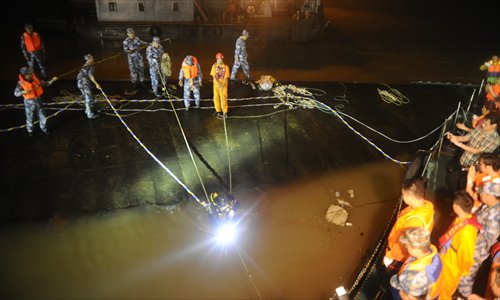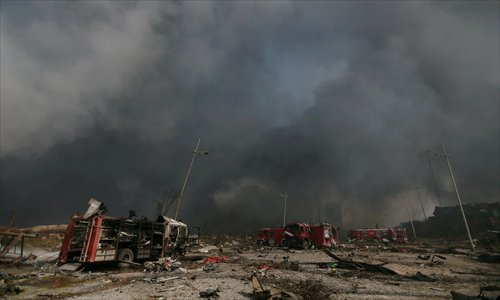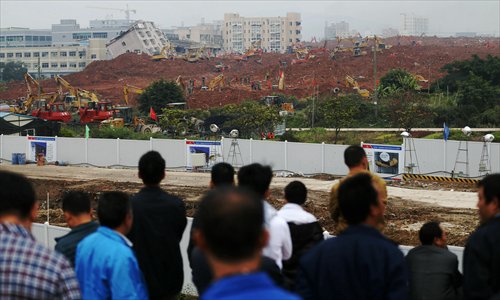HOME >> CHINA
Tragedy accompanies runaway development
By Jiang Jie and Liu Xin Source:Global Times Published: 2015-12-29 21:38:15
Eyes wet with tears shed over tragedy tend to dry quickly after media coverage fades from sight. It's not that people have grown callous, they just have short memories. However, the year 2015 was a major wake up call for many in China, including the Global Times, as major disasters rocked the entire nation, triggering discussions about the importance of safety regulations versus the country's booming economy.
Sinking star

At 9:31 pm on June 1, a cruise ship carrying 454 people capsized on the Yangtze River in Central China's Hubei Province. According to initial reports, the ship had been hit by a tornado. Buffeted by strong winds, the ship flipped over, ending 442 lives.
Only 12 people survived what was originally supposed to be a luxurious voyage from Shanghai to Chongqing, a trip which unfortunately came to an early end near the small town of Jianli, Hubei Province.
On rescue boats less than 10 meters away from the capsized ship Eastern Star, we saw death. Body after body was brought out of the turbid water. They were swollen. They were pale. Their faces unrecognizable.
Back ashore, the town of Jianli was enshrouded by the suffocating pain the relatives of the victims brought with them from across the nation. Amid the support and comfort offered the heartbroken group, laughter or smiles seemed inappropriate in face of the disaster.
Later, the National Meteorological Bureau dismissed previous media reports that put the blame on a tornado, arguing that it was unclear whether the strong convective weather had given rise to such a storm.
In the aftermath, the shipping company operating the Eastern Star was ordered to carry out an investigation into the safety condition of its ships and rectify any problems detected.
The latest update regarding the accident was in September when the State Administration of Work Safety (SAWS) said at a routine press briefing that field investigation and simulations of the Eastern Star accident had been completed.


Blood money
Two months after the Eastern Star capsized, residents near the port of Tianjin witnessed a huge explosion at 11:35 pm on August 12. Videos uploaded online depicted their range of emotions as a second even larger blast lit up the night sky, blowing in windows and transforming their initial curiosity into fear. The aftermath of the explosion was huge, not just damaging the homes of local residents, but also completely upsetting their lives.
As explosion-hit regions were quickly cordoned off by armed police, we were unable to reach the core site of blasts - a warehouse in Binhai New Area where the storage of hazardous chemicals led to deaths of 173 people, over 100 of whom were firefighters.
In a temporary mourning hall at a fire station in Binhai New Area, the pictures of the deceased firefighters were hung at the front of the hall. There we witnessed an emotionally charged press briefing as Yue Xiqiang, political commissar for the fire station, briefed reporters on the latest progress in their search and recovery efforts.
The piles of figures he briefed us on are long forgotten, but we remember the tears he was trying to hold back.
With tears shed, those who survived had to struggle on with their lives.
Preliminary counts put the number of homes affected in the blast at 17,000 homes scattered around seven residential areas, with the Haigangcheng and Qihang communities suffering the most serious damage.
We saw hundreds of residents crowd into a small petition office of the Binhai New Area government on August 20. A week into the blast, their anger and frustration had reached a peak as they were still getting by on the monthly subsidy of 2,000 yuan ($308) offered by local authorities.
However it seems this anger quickly faded away.
Pang Yu, a resident representative from the Haigangcheng community, told the Global Times that he has accepted the local government's offer to let private enterprises buy his damaged apartments at 1.3 times their market value.
"As far as I know, 95 percent [of residents] have signed the agreement. No one wants to be stuck here by the incident. We just want to find a new home and try to move on," Pang said.
When we previously talked with Pang in September, he and many residents insisted that they would never accept the offered compensation. However, now it looks like things have changed. Previously filled with heated discussions and complaints about poor regulation of the warehouse by local authorities, WeChat group discussions involving affected residents have also died down recently.
Perhaps this is the mentality that puts ordinary people's lives at risk: As life goes on, pain fades and people stop pushing for a deeper look into the causes of disaster - be they man-made or natural - beyond what is provided in a mere investigative report.
However, this just gives those who would flaunt safety regulations even more leeway.
More recently, a landslide at an industrial park in Shenzhen caused by the unsafe storage of a huge pile of construction waste destroyed a total of 33 residential and industrial buildings and left 76 lives unaccounted for at the time of this writing. Even now rescue efforts continue.
Apologies have been made and compulsory measures taken against a total of 12 people responsible for this latest disaster. However, this doesn't mean it's time to go back to business as usual.
Beneath the surface of China's rapid economic growth and soaring consumer demand lies a weak disaster prevention system that, unlike the country's fight against corruption, is not put in the spotlight frequently enough. Yet it is upon this system that the life or death of the country's citizens often hinge.
Read more in Special Coverage:

Newspaper headline: Remember the tears
Sinking star

Rescue workers search the wreckage of cruise ship Eastern Star on June 2. Photo: Li Hao/GT
At 9:31 pm on June 1, a cruise ship carrying 454 people capsized on the Yangtze River in Central China's Hubei Province. According to initial reports, the ship had been hit by a tornado. Buffeted by strong winds, the ship flipped over, ending 442 lives.
Only 12 people survived what was originally supposed to be a luxurious voyage from Shanghai to Chongqing, a trip which unfortunately came to an early end near the small town of Jianli, Hubei Province.
On rescue boats less than 10 meters away from the capsized ship Eastern Star, we saw death. Body after body was brought out of the turbid water. They were swollen. They were pale. Their faces unrecognizable.
Back ashore, the town of Jianli was enshrouded by the suffocating pain the relatives of the victims brought with them from across the nation. Amid the support and comfort offered the heartbroken group, laughter or smiles seemed inappropriate in face of the disaster.
Later, the National Meteorological Bureau dismissed previous media reports that put the blame on a tornado, arguing that it was unclear whether the strong convective weather had given rise to such a storm.
In the aftermath, the shipping company operating the Eastern Star was ordered to carry out an investigation into the safety condition of its ships and rectify any problems detected.
The latest update regarding the accident was in September when the State Administration of Work Safety (SAWS) said at a routine press briefing that field investigation and simulations of the Eastern Star accident had been completed.

Fire trucks lie destroyed on August 13, a day after explosions rock the port of Tianjin. Photo: Cui Meng/GT

Rescue crews search for survivors on December 22 after a massive landslide at an industrial park in Shenzhen. Photo: Cui Meng/GT
Blood money
Two months after the Eastern Star capsized, residents near the port of Tianjin witnessed a huge explosion at 11:35 pm on August 12. Videos uploaded online depicted their range of emotions as a second even larger blast lit up the night sky, blowing in windows and transforming their initial curiosity into fear. The aftermath of the explosion was huge, not just damaging the homes of local residents, but also completely upsetting their lives.
As explosion-hit regions were quickly cordoned off by armed police, we were unable to reach the core site of blasts - a warehouse in Binhai New Area where the storage of hazardous chemicals led to deaths of 173 people, over 100 of whom were firefighters.
In a temporary mourning hall at a fire station in Binhai New Area, the pictures of the deceased firefighters were hung at the front of the hall. There we witnessed an emotionally charged press briefing as Yue Xiqiang, political commissar for the fire station, briefed reporters on the latest progress in their search and recovery efforts.
The piles of figures he briefed us on are long forgotten, but we remember the tears he was trying to hold back.
With tears shed, those who survived had to struggle on with their lives.
Preliminary counts put the number of homes affected in the blast at 17,000 homes scattered around seven residential areas, with the Haigangcheng and Qihang communities suffering the most serious damage.
We saw hundreds of residents crowd into a small petition office of the Binhai New Area government on August 20. A week into the blast, their anger and frustration had reached a peak as they were still getting by on the monthly subsidy of 2,000 yuan ($308) offered by local authorities.
However it seems this anger quickly faded away.
Pang Yu, a resident representative from the Haigangcheng community, told the Global Times that he has accepted the local government's offer to let private enterprises buy his damaged apartments at 1.3 times their market value.
"As far as I know, 95 percent [of residents] have signed the agreement. No one wants to be stuck here by the incident. We just want to find a new home and try to move on," Pang said.
When we previously talked with Pang in September, he and many residents insisted that they would never accept the offered compensation. However, now it looks like things have changed. Previously filled with heated discussions and complaints about poor regulation of the warehouse by local authorities, WeChat group discussions involving affected residents have also died down recently.
Perhaps this is the mentality that puts ordinary people's lives at risk: As life goes on, pain fades and people stop pushing for a deeper look into the causes of disaster - be they man-made or natural - beyond what is provided in a mere investigative report.
However, this just gives those who would flaunt safety regulations even more leeway.
More recently, a landslide at an industrial park in Shenzhen caused by the unsafe storage of a huge pile of construction waste destroyed a total of 33 residential and industrial buildings and left 76 lives unaccounted for at the time of this writing. Even now rescue efforts continue.
Apologies have been made and compulsory measures taken against a total of 12 people responsible for this latest disaster. However, this doesn't mean it's time to go back to business as usual.
Beneath the surface of China's rapid economic growth and soaring consumer demand lies a weak disaster prevention system that, unlike the country's fight against corruption, is not put in the spotlight frequently enough. Yet it is upon this system that the life or death of the country's citizens often hinge.
Read more in Special Coverage:

Newspaper headline: Remember the tears
Posted in: